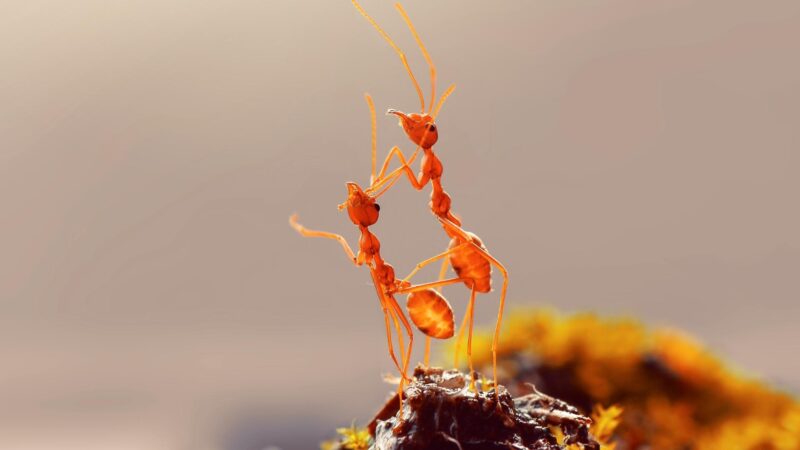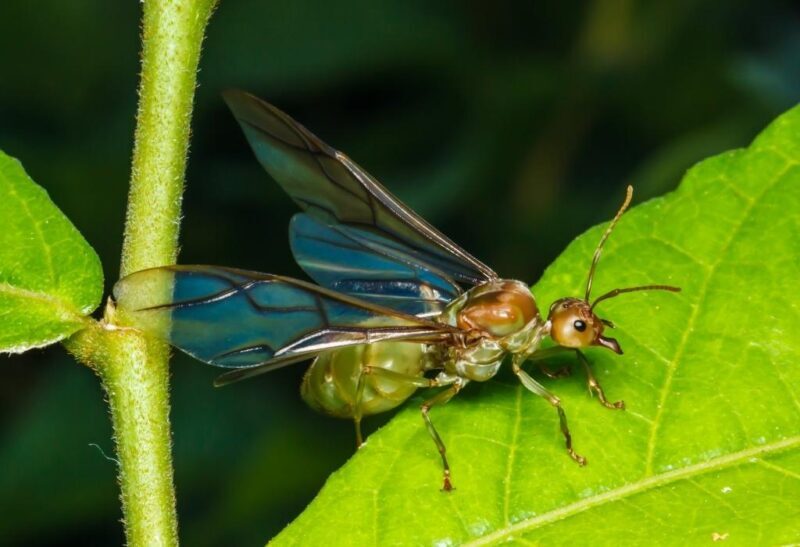Every ant colony is organized in a well-defined hierarchy. This hierarchy is organized into layers: a queen at the very top, workers below her, soldiers on top of them, then foragers, and so on. Apart from these members of a hierarchy, have you ever wondered whether king ants exist?
Ant colonies are typically led by queens. Its main function is to lead ants and lay thousands of eggs that become larvae and eventually ants. They don’t have the concept of a king since their hierarchy is based on a caste system, meaning they have different roles within the colony – workers, soldiers, and most importantly a queen.
In this article, you will learn interesting facts about ants’ colonies and overall hierarchy.
Table of Contents
Different Roles of Ants

Ants’ colonies have a specific structure. There are castes of individuals that perform specific functions within the colony.
Workers are the smallest caste found in an ant colony. They do all of the work for the colony: building new nest sites, gathering food, and tending to any injured members of their colony.
Soldiers perform a similar function as workers. But they can also be called upon to defend against attacks from predators or other colonies of ants.
On the other hand, queens do not have any functions within a typical ant colony. They are born into the world as part of a queen egg that hatches out into an adult female ant capable of laying eggs herself!
Does the Queen Ant Have a King?

Queen ant doesn’t have a king. The queen ant is the only fertile member of her colony. The queen ant mates with several males during one mating season, which lasts for about 10 days.
Once fertilized by a male, she lays her eggs in a large underground chamber that serves as her nursery. During this time, she does not move from her nursery chamber.
After laying her eggs, she seals herself inside the nursery chamber with other nurse ants and continues to lay more eggs until it becomes filled with larvae.
When the larvae are fully grown and ready to emerge as adult ants, they will begin to leave the chambers where they hatched and go out into their natural habitats.
How Can You Tell a Male From a Female Ant?

The easiest way to tell a male ant from a female is to look at its antennae. They have an elongated abdomen, which is usually longer than their thorax. The head of the male ant is also wider than the thorax, and it has a pair of wings that look like they are missing a couple of segments.
Males have longer antennae than females, and they also have a slightly paler color. If you’re curious, you can also look at the thorax (the middle part of an ant’s body). Male ants have broad, flattened abdomens with more hair and fewer segments than females.
On the one hand, female ants do not have wings. Instead, they have two large and four small eyes that are located on top of her head (the antennae are located underneath).
She also has a broad abdomen that extends beyond her head and thorax. This is different from the male ant’s abdomen, which stops before it reaches its wings.
Are Queen Ants Male or Female?

Queen ants are female. The queen ant is a mature female that controls all aspects of reproduction in a colony. Once she has mated several males, she will begin to lay eggs.
Does the Reproduction of Ants Require a King?
The queen ant does not specifically need to have a king to reproduce, since the concept of having a “king” ant does not even exist in their hierarchy. Instead, the queen ant needs a male to produce offspring.
The sponges (the larvae) of ants are hermaphrodites, which means they have both male and female reproductive organs.
The queen ant only needs one of those reproductive organs so she can have sex with many different males at once! For the queen ant to reproduce, she must be able to mate with multiple males at once.
This is why she has two ovaries on her back; one ovary will produce eggs while the other will produce sperm. She can fertilize multiple eggs at once by having sex with different males on different days.
How Does a Queen Ant Become Queen?

The queen ant is the queen of the colony because she can produce eggs, which are the only way to pass on her genes. The female ants in a colony will lay eggs as soon as she is old enough to reproduce. The queen’s eggs hatch and become new queens, who will then create more eggs or workers.
The queen ant has special glands that help her produce eggs, which are larger than normal ants’ eggs. This gland also helps her to determine when she is fertile and ready to reproduce, so she only produces fertilized eggs when it is time. The other ants do not have this ability, so they cannot reproduce on their own.
What Is the Queen Ant’s Role in the Colony?

Queen ants are the most powerful members of a colony of ants. They are usually larger and more dominant than the workers, and they can reproduce and pass on their genes to their offspring.
The queens’ ability to reproduce is what makes them so important in a colony and what makes them considered queen ants! For a colony to survive, it must be able to produce more workers and soldiers than it has members.
If the queen dies or is removed from the colony, there will be no more workers or soldiers, and the colony will die out. The queen is also responsible for making sure that her genetics are passed on through her eggs.
If she dies while laying eggs, those eggs will not hatch into larvae that can become workers or soldiers. They will only hatch into larvae that will grow up into queens themselves.
What Happens When the Queen Ant Dies?
When a queen ant dies, her colony will start to weaken. The workers that were responsible for taking care of their queen will start to die off as well. This can happen very quickly, and the colony may be completely wiped out within a day or two of the queen’s death
Without a queen to lead them, the workers that remain in the colony are limited in what they can do for themselves. They will become more vulnerable to disease and predators and may even starve if there is not enough food for them to eat.
In addition to being able to make decisions about when to feed themselves and how many times they should lay eggs each day, queens also serve as a source of genetic diversity in their colonies. With no queen around anymore, this diversity is lost—and so are their chances at survival.
What Are the Reasons Why King Ants Don’t Exist?
Unlike our concept of monarchy, there is no single “ant king” who rules over a particular entire colony of ants. Instead, each ant has its role within the colony and fulfills different roles depending on what it needs at any given time, as queen ants are there to simply lay eggs.
Frequently Asked Questions
Are There Queen Ants?
There are queen ants. Queen ants are large ants that lead their colonies. They have large heads and mandibles, which they use to defend the colony and make decisions about what to do. Surprisingly, they have wings, but they do not fly.
Should I Kill the Queen Ant?
If you’re a homeowner and you find that your property is infested by an excessive number of ants, killing the queen ant would be the most effective idea to get rid of them your property. However, it may be best to do it by calling a professional exterminator to make sure that doing it will not cause harm to you.
On the one hand, when you see a colony and it does not cause any problem, killing the queen ant shouldn’t be necessary. Queen ants are a crucial part of the ecosystem. They are responsible for laying eggs and creating a colony, which allows them to survive.
Without queen ants, the colony would not be able to reproduce and continue to grow. If you kill a queen ant, the rest of the colony will likely die out as well.
Queen ants live for about nine years—the same amount of time that it takes for colonies to reach maturity. If you kill a queen ant before her time has come, there is no way for her to continue laying eggs and producing new queens.
How Is a Queen Ant Born?
Queen ants are born as wingless females. They do not have wings until they reach adulthood when they begin to develop wings. When the queen ant is born, she develops a small head and thorax that allows her to move around on her own.
The queen ant then begins to grow legs and antennae, as well as mandibles, which are used for chewing. At this stage of development, the queen ant is called a pupated ant (or “queen”). Queen ants are fed by workers and soldiers during their infancy, but once they become adults they can forage for food on their own.
In a nutshell, there is no such thing as a monarch in an ant colony. Because there is a caste structure, however, in ant colonies, wherein different ants play various functions.
They are social insects, and their colonies are made up of workers, soldiers, and—most significantly—queens, whose primary duties are to guide the colony and deposit a large number of eggs that will ultimately develop into larvae and ants.
List of Sources
Jaffé, R., et al. (2007). Worker caste determination in the army ant Eciton burchellii. Biology letters.
Funaro, C. F., Schal, C., Vargo, E. L. (2019). Queen and king recognition in the subterranean termite, Reticulitermes flavipes: Evidence for royal recognition pheromones. PloS one.
Holbrook, T. (2009). Individual Life Cycle of Ants. ASU – Ask A Biologist.
Ants of the North Quabbin Region, Body Structure. Harvard Forest.
